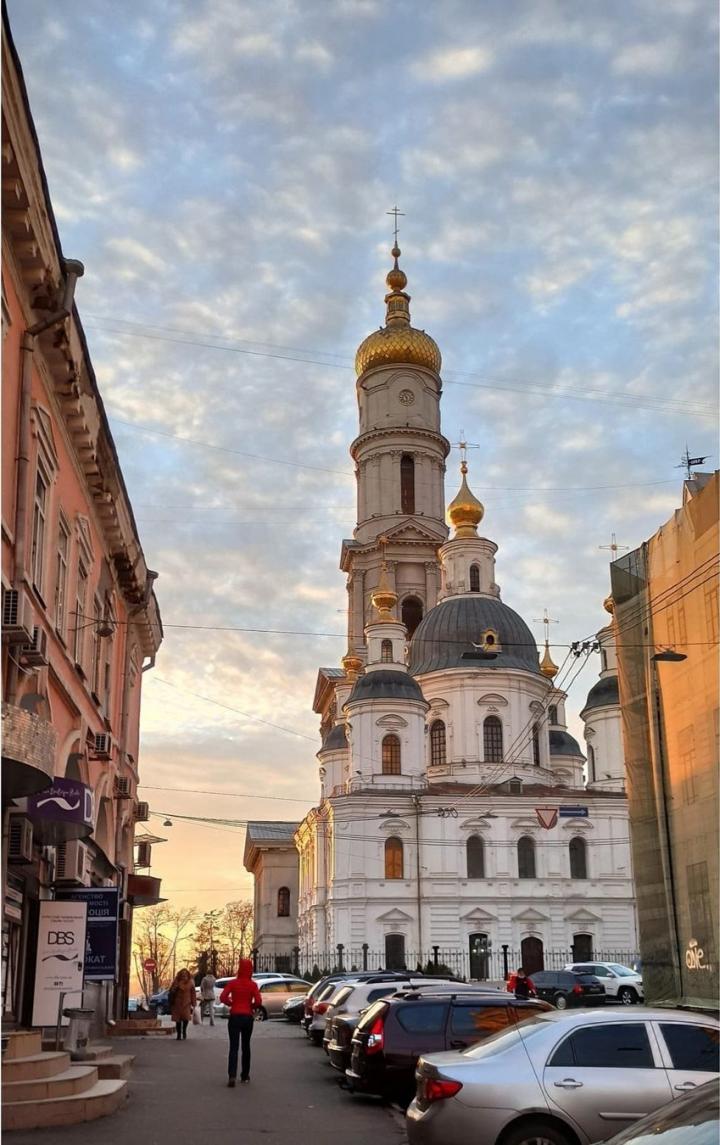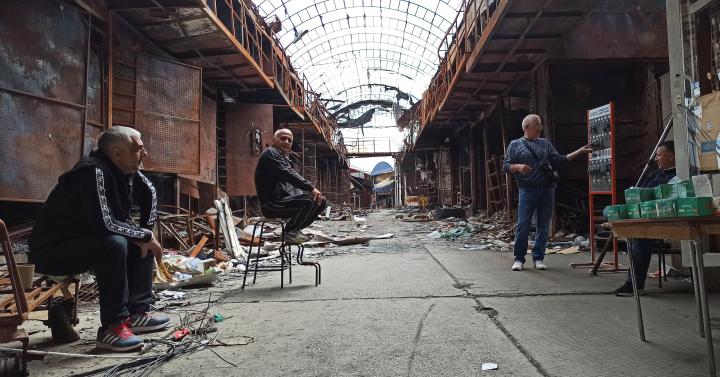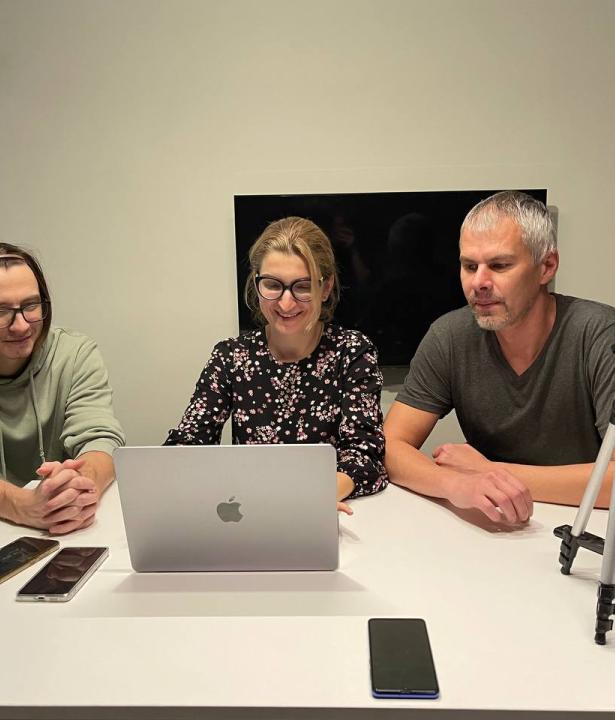The initiators of the interview project stayed in Kharkiv during the continuous attacks. Iryna Skyrda, a member of Young Kharkiv, talks about what was special about the city and how it changed as a result of the war.
Text
Kharkiv, beloved city. What was it like before 24 February 2022?
The city is a metropolis, which had a population of between 1.7 and 2 million prior to the outbreak of war. It was and is the central regional administrative hub in north-east Ukraine.
What makes our city so special
Text
After the Revolution of 1917, Kharkiv was the capital of Ukraine for more than a decade. During this period, it was the social, political, and economic center of the country. Its period as capital city permanently changed the cityscape of the metropolis. The monumental Derzhprom building complex or State Industry Building dates from this time, and it has been a symbol of the city ever since its construction as the first Ukrainian skyscraper. The enormous square in front of the building was developed as one of the largest city squares in Europe at the time, a title that it still retains.
The city itself, however, is significantly older. Its history spans more than three and a half centuries: centuries marked by beautiful and tragic events. The
cathedral triangle
cathedral triangle
These are the Pokrovski Monastery, the Assumption Cathedral and the Annunciation Cathedral (Svyato-Blahovishshenskiy kafedralnyj sobor)
, for example, is characteristic of the historic city centre. The of worship situated around the lively cathedral square represent three different architectural styles. The first was built in the so-called “
Cossack Baroque
Ukrainian Baroque
Ukrainian Baroque, also known as Cossack Baroque, is an art movement that started in the 17th century in the autonomous Hetmanate or Hetman State and the associated Slobidska Ukraine. Ukrainian Baroque is also called Cossack Baroque since it was above all the Cossacks who promoted architecture and painting during this period. In comparison with the Baroque styles of Western Europe, Ukrainian Baroque architecture was more moderate in its ornamentation and simpler in form.
“ (also known as Ukrainian Baroque), the second is classical and the third combines Gothic and Balkan-Byzantine elements.A further landmark of the city is Gorky Park (renamed “Central Park for Culture and Recreation” in 2023), which had become one of the most impressive amusement parks not only in Ukraine but perhaps even in Europe in recent years. The park was charming, well-tended and modern. Its numerous cafes, the rollercoasters for every taste and the idyllic swan lake were all very popular. However, locals and tourists also enjoyed spending time in both of the city’s zoos. The Central Zoo, the oldest in Ukraine, was opened in 1896 and was home to more than 7,000 animals and as many as 400 animal species. The Feldman Ecopark, a private zoo, was smaller but no less attractive. Entry to the Ecopark was free and the little ones were often treated to an ice cream there.
Kharkiv was also the unofficial shopping capital of Ukraine. The famous Barabashovo Market, one of the largest markets in the world, with an area of 75 hectares and 20,000 stalls, was particularly impressive. However, the famous Kharkiv shopping centres and large supermarkets, such as the “Nikolsky”, were also not to be missed.
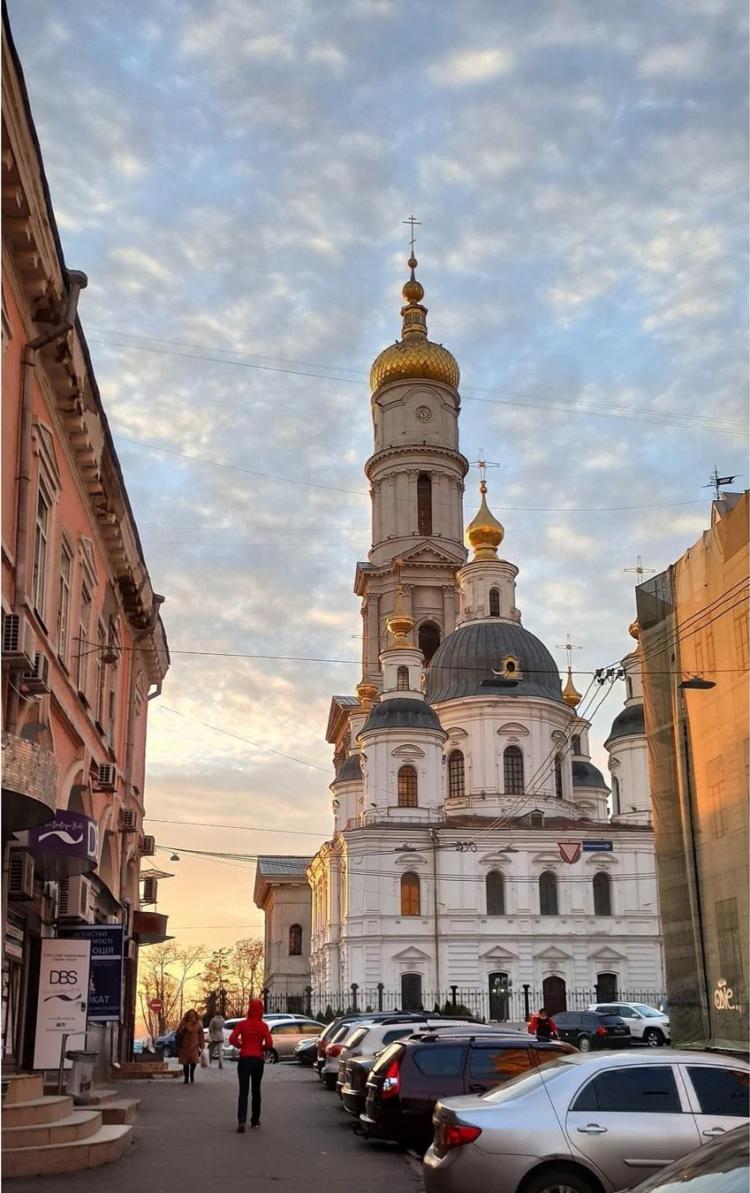
The Church of the Assumption in Kharkiv. Vladyslav Vinogradoff, Free access - no reuse
The Church of the Assumption in Kharkiv. Vladyslav Vinogradoff, Free access - no reuse
Our city in ruins
Text
Our hometown of Kharkiv was all this and much more until the morning of 24 February 2022, when the invasion by Russia of the whole of Ukraine brought our whole world tumbling down. For more than half a year, Kharkiv, which is only 40 kilometers from the Russian border, has been regularly bombarded with missiles. Since the start of the war, Russian troops have been systematically destroying the center of this historic and significant city. In addition to administrative buildings, universities, colleges and schools, the Korolenko State Scientific Library, monuments and apartment blocks have been partially or completely destroyed. While the city centre used to be full of people - buskers played here, skateboarders practiced their tricks near the Opera, residents and tourists sat by the fountains and strolled through 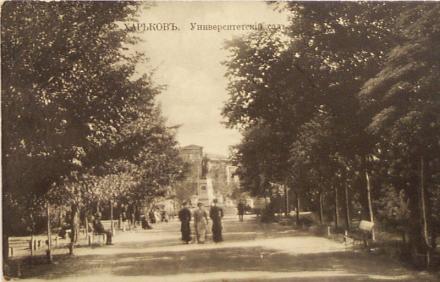 - today a walk through the central part of the city leaves a somber impression: ghost houses with broken windows, buildings destroyed by rockets and, on the streets, just a few lonely figures running necessary errands.
- today a walk through the central part of the city leaves a somber impression: ghost houses with broken windows, buildings destroyed by rockets and, on the streets, just a few lonely figures running necessary errands.

Sad ìmenì Tarasa Ševčenka
ukr. Unìversitetsʹkij sad, deu. Schewtschenko-Park, eng. Shevchenko Park, ukr. Sad ìm. T.G. Ševčenka, rus. Universitetskij sad, rus. Gorodskoj sad imeni Ševčenko, rus. Gorodskoj sad im. T.G. Ševčenko, rus. Сад им. Т.Г. Шевченко, rus. Университетский сад, ukr. Сад ім. Т.Г. Шевченка, ukr. Університетський сад, ukr. Сад імені Тараса Шевченка, rus. Городской сад имени Шевченко, ukr. Sad im. T.H. Ševčenka, ukr. Universytetsʹkyj sad, ukr. Sad imeni Tarasa Ševčenka, deu. Taras-Ševčenko-Botanischer Garten, deu. Taras-Schewtschenko-Botanischer Garten, rus. Sad imeni Tarasa Ševčenko, rus. Сад им. Тараса Шевченко
The Taras Shevchenko Park was laid out at the start of the 19th century by Vasyli Karazin, the founder of the famous University of Kharkiv, and is one of the oldest parks in the city. The zoo, which still exists, also dates from this time. Originally the park comprised a landscape park and a botanical garden, but it was redeveloped in the 20th century. Today the Shevchenko Park is famous for its many fountains and monuments.
The area of Kharkiv that has been hardest hit is North Saltivka, which today is also referred to as the ghost district. North Saltivka used to be the youngest and most densely populated neighborhood. Today it is the most heavily damaged neighborhood. Of the nearly 200,000 people who lived in this area before the war, according to the more optimistic estimates, less than a thousand remain. It is as if the streets have been swept clean of people; children’s laughter is only seldom heard, and the city is muted except for the thundering of the missiles.
One of the few residents of North Saltivka who is still here describes her life as follows: “I go to sleep to the sound of
“hail“
“hail“
This refers to the projectiles of the BM-21 multiple rocket launcher system.
and when I wake up, there is an ominous silence. This silence is regularly interrupted by explosions, artillery and rocket fire.” Most of the former residents have left North Saltivka: some have gone abroad; others have fled to safer places in Ukraine. Even in Kharkiv itself, the war has created “internal refugees” - people who have moved from “Kharkiv to Kharkiv”. At first, many held on in the metro tunnels, in the hope that it would all soon be over. But when the war showed no sign of ending, they began seeking refuge in other areas of the city.
Another unsafe district is Shevchenkivs‘kyi. A tragedy occurred there on 26 May 2022. The neighborhood was hit by Russian bombs. When the bombardment began, a young family was just strolling through the city: a woman and a man with a 5-month-old baby on his arm. The man died on the spot, and the woman was taken to hospital in a critical condition. Later the police also found the corpse of the baby, which had been flung out of the arms of its father and onto the roof of a nearby stairwell. A further eight civilians were killed and 18 wounded in the attack. Even on Kharkiv Day, 23 August, the occupiers fired on the district three times.
The damage caused by the constant attacks are substantial. Even Gorky Park, the place that is so popular with residents, has been hit several times by Russian rockets, and its sports facilities, cafes and amusement rides have been destroyed. The Feldman Ecopark was hit by several grenades on the first day of the large-scale attack on Ukraine. Six employees and volunteers at the park have been killed since the beginning of the war, and the evacuation of the animals was dramatic.
Barabashovo Market has also been hit repeatedly. When the first massive bombardment took place in early March 2022, a major fire was started which spread out over several hectares. While the fire was being extinguished the market was bombed again, and one fireman was killed, another injured. The market was attacked again on 25 March 2022. The Central Market, the Heroes of Labor Market (Heroyiv Pratsi) and a series of other markets in different districts of the city were also the target of enemy fire. The shopping centres of Kharkiv were also attacked. On 9 March 2022 the occupiers hit the Nikolsky shopping and entertainment centre. On 7 April a fire was started by the bombardment of the Karavan shopping centre in North Saltivka, which spread out over 2,500 square meters. On 7 June a Russian rocket landed in the Vostorg supermarket near the Industrialna metro station – the list goes on and on.
A further target of the Russian attacks is the infrastructure that the occupiers are deliberately trying to destroy: electricity plants, gas, water and heat supply systems, petrol stations, transport depots, railway tracks, power lines for electric transport and telecommunications infrastructure.
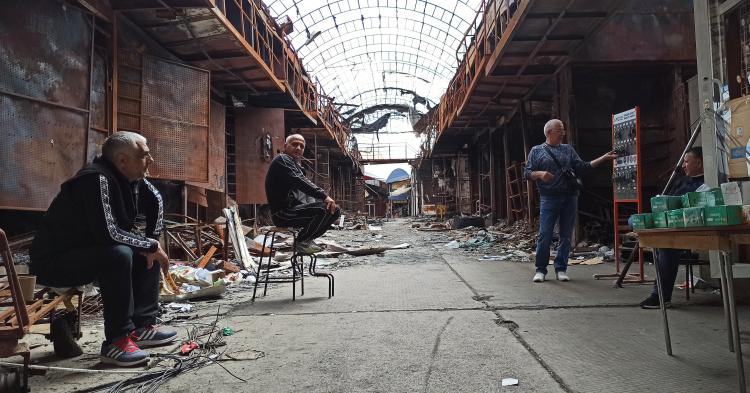
The Barabashovo market after its destruction in March 2022. Vladyslav Vinogradoff, Free access - no reuse
The Barabashovo market after its destruction in March 2022. Vladyslav Vinogradoff, Free access - no reuse
Text
You might think it would be completely impossible to live under such conditions. But appearances can be deceptive, since “Kharkiv is made from reinforced concrete.” This phrase has become the slogan for the defence of Kharkiv. I would like to report how this very impressive emblem, which has become the lived experience of so many who are still resident in Kharkiv, came about. Its creator, the Kharkiv artist
Patrick Cassanelli
Patrick Cassanelli
Patrick (Ilya) Cassanelli lives in Kharkiv and comes from a Crimean-Italian family. He is a graphic artist and designer and designs mainly posters. In 2014 he worked as a paramedic during the Maidan Revolution. He designed the emblem “Kharkiv is made from reinforced concrete” during the first days of the war. All proceeds raised by the logo are donated to the Ukrainian army. T-shirts, stickers and sew-on patches with the logo are available.
drew on the motif of the
Derzhprom high-rise
Derzhprom
“Derzhprom” is an acronym, composed of the words derzh, an abbreviation of the Ukrainian word derzhava (state), and prom from the Ukrainian word promislovist (industry). “Derzhprom“ refers to the State Industry Building in Kharkiv, that was completed in 1928 while Kharkiv was the capital of Soviet Ukraine. The constructivist building complex is made up of three H-shaped sections. When it was completed “Derzhprom“ was the first Soviet high-rise and the second tallest building in Europe. As well as the Ukrainian acronym, it was also given the Russian acronym “Gosprom”.
, the symbol of Kharkiv, and also the first European skyscraper made monolithic reinforced concrete. Following a further air-raid, Cassanelli added the wording, “Kharkiv is made of reinforced concrete”. The artist used the emblem to symbolize a fortified town with reinforced concrete walls, which is not only impregnable, but which will never give up, and which defies the terrible attack on its people, their lives, and its architecture.The city has been under constant missile and artillery fire since the first days of the full-scale invasion. With all its inhabitants it really has come to resemble a monolithic block of reinforced concrete and is described as such due ability to resist the Russian attackers. In an interview with the journalist Sofiya Tsvetkova, Cassanelli said:
“I did not expect the emblem to become so popular. My audience has always been small, since not everyone, not even everyone who is involved with art, is fond of avant-garde art. […] But it turned out that a lot of people seem to be 'on the same wavelength' as me. If you ask me what the emblem means to other people from Kharkiv, I think everyone should make up their own mind. But for everyone involved, the slogan 'Kharkiv is made from reinforced concrete' refers to a particular story of resistance.”
Who fights for freedom every day?
Text
Kharkiv has been resisting the Russian attacks since the first days of the war. It is therefore impossible to avoid saying something about those who are changing Kharkiv into this “reinforced concrete”. In the first place these are our defenders (AFU, the National Guard, TRO), who have been reliably holding the position at the front since the first days of the war. Thanks to them, the front line was forced back from Kharkiv to the East, the city has been hit far less often by enemy artillery, and air attacks have been prevented or repelled.
The emergency services in Kharkiv have also been a reliable pillar of support for the city, risking their lives every day to extinguish fires caused by shelling, to rescue people from the ruins and provide help. Life in this city at the frontline would be unimaginable without their work.
But the employees of the city of Kharkiv, who are on duty every day, are also among the true heroes of Kharkiv. The city is cleaned up, refuse is dealt with, the communication infrastructure is restored, and flower beds are planted. Kharkiv is neat and tidy, even under the harsh conditions of war.
The volunteers of Kharkiv are another group of heroes in this war: since the beginning of the Russian invasion, they have organised humanitarian aid deliveries to the most dangerous areas of the city, evacuated people from firing zones, collected money to support the army, secured food for the needy and cared for our four-legged friends…
We are also proud of the doctors and medical professionals of Kharkiv. The medical facilities of the city have been in continuous operation since the start of the Russian invasion and are working under emergency conditions. Medical teams regularly make their way to air raid shelters or metro stations where people are sheltering from bombardments and shelling, in order to examine them and provide them with the necessary medication. The provide medical help to all who need it, and give their very best, especially as hospitals, blood transfusion centres, pharmacies etc. have gradually been destroyed. With their help, around a thousand babies have been born since the start of the war.
The main element of this reinforced concrete, however, is made up of the ordinary citizens of Kharkiv. Those who remained in the city, as well as those who found it impossible to live exile or forced migration and returned; those are working bravely under war conditions: baking bread, providing humanitarian aid, teaching children and healing people; those who are simply surviving under the inhuman conditions of war.
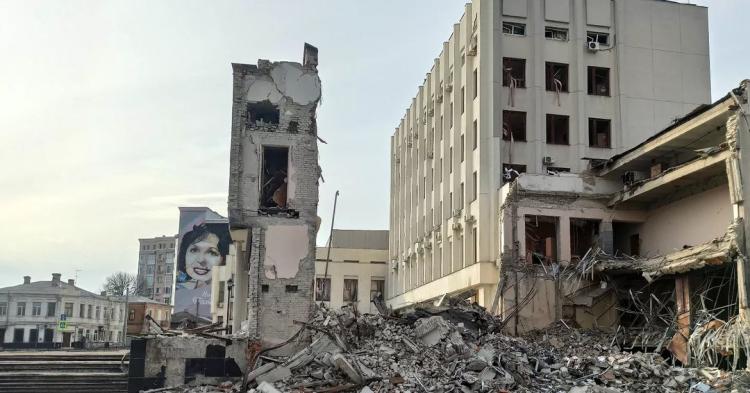
The wounds of the favorite city. The consequences of the shelling of Kharkiv by Russian troops, March 26, 2022. Vladyslav Vinogradoff, Free access - no reuse
The wounds of the favorite city. The consequences of the shelling of Kharkiv by Russian troops, March 26, 2022. Vladyslav Vinogradoff, Free access - no reuse
Text
Editor's note: The article was written in autumn 2022.
The photos accompanying this text were taken by Vladyslav Vinogradoff. With a loving eye, he documents the injuries, but also the beauty of his city and the Kharkiv region after 24 February 2022 (Instagram vlad.vinogradoff).
English translation: Gwen Clayton


